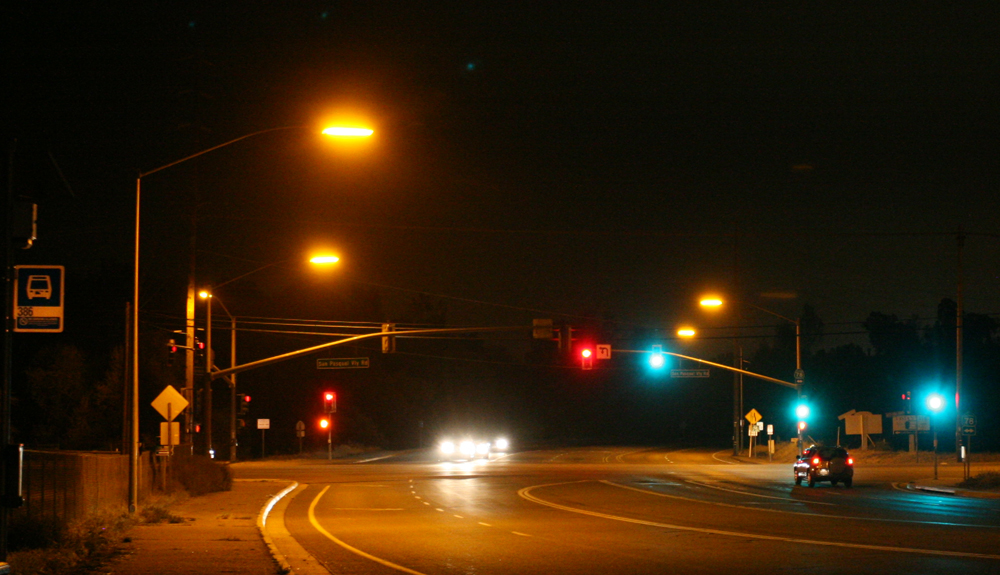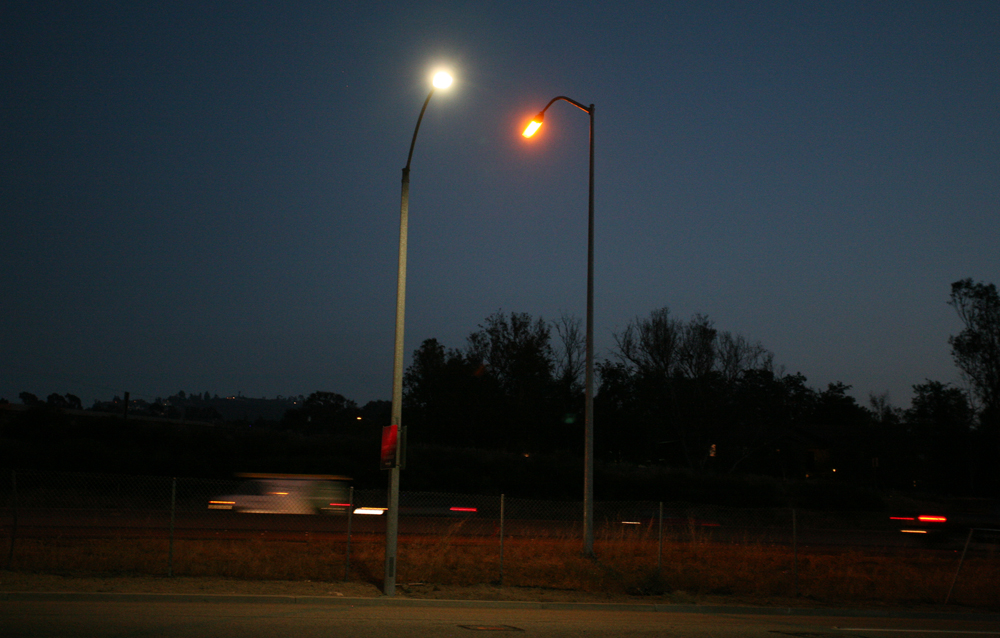 It would be impractical and unsafe to keep our cities and streets completely dark, but it would be great for astronomy. Streetlights are needed and the type that astronomers really like is low-pressure sodium (LPS).
It would be impractical and unsafe to keep our cities and streets completely dark, but it would be great for astronomy. Streetlights are needed and the type that astronomers really like is low-pressure sodium (LPS).The big advantage of LPS for astronomy is that it puts out a very limited range of color. This limited set of colors can easily be filtered out by astronomers, who then can use the rest of the color spectrum to study the universe.
Here is an example of what I am talking about. Below are two street lights. On the left is a new broad-spectrum (aka white) induction currently being tested by the City of San Marcos, CA. On the right is a Caltrans LPS light over Highway 78.
 If you take the light being give off by each fixture and pass it through a diffraction grating (something like a prism that splits light into its component colors) you can see this:
If you take the light being give off by each fixture and pass it through a diffraction grating (something like a prism that splits light into its component colors) you can see this:
The spectrum on the top is from the white induction light and just below it is the spectrum from the LPS light. Notice that the induction light has essentially a full rainbow of colors, but the LPS has a very limited number of colors. So you can see why it so appealing to astronomers. There is very little color to get in the way of astronomical research.
Here is a close-up of the spectrum of just the induction light (with the light itself on the right):
 One of the draw backs to astronomy is the all of the blue light in the spectrum. The short wavelength of blue light makes it more likely to reflect off of the ground and up into the sky. So even if you have a good light fixture that directs all of its light downward you'll get a brighter sky than if you used LPS lights.
One of the draw backs to astronomy is the all of the blue light in the spectrum. The short wavelength of blue light makes it more likely to reflect off of the ground and up into the sky. So even if you have a good light fixture that directs all of its light downward you'll get a brighter sky than if you used LPS lights.The limited color in LPS light does pose a problem for anyone that needs to accurately determine color under just that light source. That, along with potential energy savings, are part of the reasons that many cities are now looking toward new lighting technologies.
The energy savings question is a bit muddled though. Low-pressure sodium is still the most efficient lighting source around. It is about three times more efficient than the best LED lights around these days. But the extra colors in a LED or induction streetlight make them look brighter to the eye than a LPS streetlight of the same brightness. This can allow cities to actually use dimmer lights whithout people even noticing.
It is vitally important that if existing LPS (or even high-pressure sodium) streetlights are replaced with new induction or LED lights that the new lights be of lower lighting levels. Without that the sky will just get brighter for everyone and streets will be over illuminated. In the end we would all lose.



9 comments:
Hoping you might know the answer to this question- are currently manufactured LPS lights capable of being dimmed?
Not that I am aware of.
I do not know the details, but it is my understanding that a dual ballast configuration can be implemented which would allow a LPS lumiere to be run at two different lighting levels (i.e. dimmable to one level). I get the sense that this is not a common configuration, nor is it especially affordable. Yet it might be considered superior to a less efficient, fully dimmable, and very expensive LED fixture in certain applications.
You stated that LPS lights are 3 times more efficient than LED light; however, this is contrarry to literature i've read so far. Were you refering to the energy use or cost.
Low-pressure sodium lamps are the most efficient source of light commercially available, up to 183 lumens per watt.
It may be that LEDs are now higher and the "3 times" statement may now longer be valid.
Scott, you are right, LED'S are not there yet. LED'S are still around 60-80 lm/w.. give it time though. they will get there. in the meantime i am still specifying other hid sources.
It might be worth trying to pull in the FCC.
This may sound odd but Radio communications are getting ever higher in frequency and optical modulation is already here, just not used much. One day the FCC will get pulled in, and we astronomers could do with them getting involved now.
If the FCC were to step in and legally manage the optical band we could achieve several things.
1. Infrared illumination could be corralled onto one band instead of two... good for NIR observations.
2. Outdoor lighting could be given, say, 3 distinct bands, the Na band and two others, so that outdoor LED lights then have, by law, to be on one of three colour bands, thus enabling astronomers to remove these bands.
3. They could impose limits on lighting levels for different uses, in the same way that the amateur radio bands are power limited... again working with town planners etc.
4. Provide optical communication 'corridors'.
5. give a blanket 'science' allocation to the majority of the optical band.
Clearly it would be beyond them to police this, but they could start the ball rolling and allow policing by local authorities etc. The primary advantage is this would push the lamp and LED manufacturers onto specific frequencies... This aspect they could police quite easily.
Derek
The City of San Diego is proposing to change out all HPS light with broad spectrum induction lighting. How will that affect the night sky? Why can't they just reduce the HPS light levels?
Well whether LPS or LED its not a problem to use unless its not an energy efficient, that's a big prob. well thank's for information and I have a new knowledge from your blog.
Post a Comment